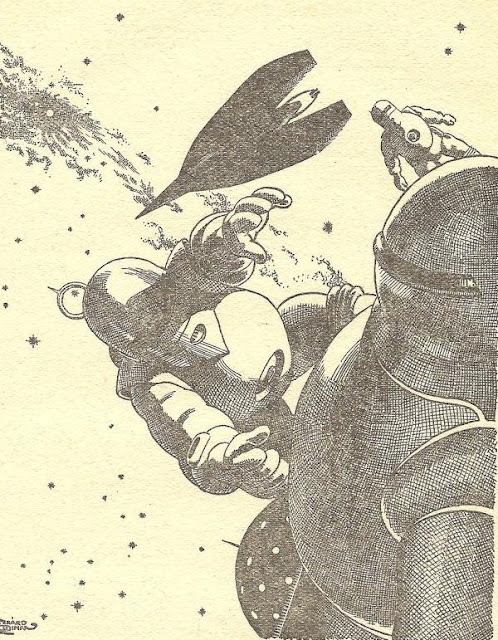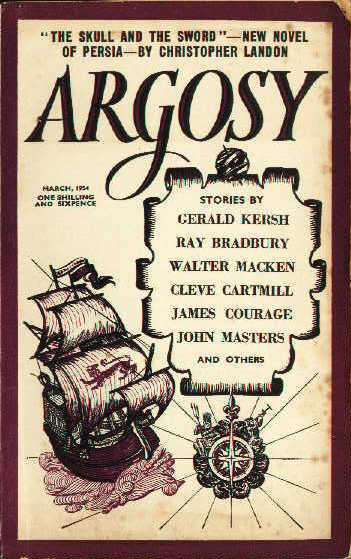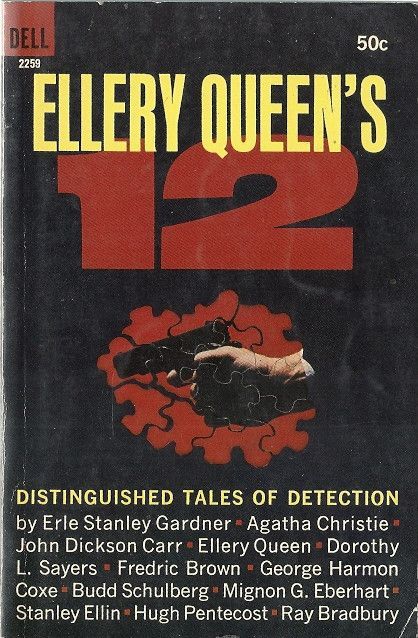"Puzzle for Spacemen."
Illustration by Quinn (1927-2015; ISFDb HERE).
First appearance: New Worlds Science Fiction, December 1955.
Reprints include:
No Future in It (1962)
Special Wonder (1970)
Special Wonder, Volume 1 (1971)
Future Crimes (2021)
Reprints page (ISFDb HERE).
Novelette (24 pages).
Online at The Luminist Archives (HERE; go to text page 40) and Archive.org (HERE; go to text page 40).
(Parental caution: Strong language.)
"A man who has been subjected to fourteen pounds’ explosive decompression is not a pretty sight."
Jennings has a problem: "He was not welcome; to these men, anyone prying into violent death was ghoulish, because it was always a dreaded and imminent fact to them. Death in space was usually swift and accountable; if there was ever a mystery, the black maw of the void swallowed it beyond the reach of man." With this and those other difficulties that he's confronted with, then, it's not surprising to Jennings that proving what seems to be an accidental death was actually a murder isn't going to be easy—not easy at all . . .
Principal characters:
~ Clore:
"Preserved by the unchanging vacuum, Clore was not nice to look at."
~ Yannick Huyghens:
"Try as he would, the problem which had defeated him a dozen times defeated him again; perhaps his very desperation was blinding him."
~ Louis Baron:
"I’ve been checking our orbit — the total orbit of the system, that is. Looks like we underestimated dust-drag a bit."
~ Klaus:
"Seems you were right about there being two men on board. Clore left Pluto with another of your employees, an agent called Klaus, who was trying to make Mars."
~ Kurt Lochmann:
"The damned man doesn’t do anything, but it’s just his being here which is bad. I had a bad dream last night from it.”
~ Hal Jennings:
"As a psychologist, of course, I'm certain it was murder."
~ Dr. Meadows:
"Men in isolated conditions have always hated the presence of death — it’s a basic prejudice which we shall probably never eliminate altogether."
Sadly for some, when humankind moves off-planet, space will become their final frontier:
"I know a little about the laws relating to criminal insanity. There has never before been a murder in space, except for those caused by maniacs who later committed suicide. Most deaths off the surface of a planet occur through accident or, more rarely, nervous break-down."
References and resources:
- "Our ’fax equipment":
Fax machines have a surprisingly long history, nearly 180 years. (Wikipedia HERE.)
- "Out here sanity is at a premium":
"The psychological effects of living in space have not been clearly analyzed but analogies on Earth do exist, such as Arctic research stations and submarines. The enormous stress on the crew, coupled with the body adapting to other environmental changes, can result in anxiety, insomnia and depression." (Wikipedia HERE and HERE.) (Also see the NASA book Psychology of Space Exploration HERE.)
- "It cost my firm three thousand credits to get me here":
For some reason science fiction writers seem to think that "dollars" aren't in our future: "The use of 'credits' is particularly common in futuristic settings, so much so that Sam Humphries has pointed it out as a cliché: 'In any science-fiction movie, anywhere in the galaxy, currency is referred to as "credits".' Credits are frequently envisioned as a form of electronic money." (Wikipedia HERE.)
- "You Earth-bound desk pilots don’t seem to have heard about relativity. Out here, we trip over it every time we fiddle with long-distance radio":
In science fiction stories it's always assumed that communications signals will travel, like on Earth today, at the speed of light—unless, that is, the author has dreamed up some sort of F(aster)T(han)L(ight) comm system; otherwise we're confined to Einstein's theory: "The principle of invariant light speed – '... light is always propagated in empty space with a definite velocity [speed] c which is independent of the state of motion of the emitting body.' That is, light in vacuum propagates with the speed c (a fixed constant, independent of direction) in at least one system of inertial coordinates (the 'stationary system'), regardless
of the state of motion of the light source." (Wikipedia HERE.)
- "the unchanging vacuum":
"Outer space has very low density and pressure, and is the closest physical approximation of a perfect vacuum. But no vacuum is truly perfect, not even in interstellar space, where there are still a few hydrogen atoms per cubic meter." (Wikipedia HERE.) "Out in space, sudden exposure of an unprotected human to very low pressure, such as during a rapid decompression, can cause pulmonary barotrauma—a rupture of the lungs, due to the large pressure differential between inside and outside the chest. Even if the subject's airway is fully open, the flow of air through the windpipe may be too slow to prevent the rupture. Rapid decompression can rupture eardrums and sinuses, bruising and blood seep can occur in soft tissues, and shock can cause an increase in oxygen consumption that leads to hypoxia." (Wikipedia HERE.)
- "caused by the magnets on his boots":
"Although many science fiction works assume some type of artificial gravity or use
rotation to 'create' gravity, magnetic boots still feature for purposes of exterior repairs
or in emergency situations." (Wikipedia HERE.)
- "mentally reviewed the current ephemeris":
"Solar System ephemerides are essential for the navigation of spacecraft and for all kinds of space observations of the planets, their natural satellites, stars, and galaxies." (Wikipedia HERE.)
- "this rash of building on Io":
Trying to construct something on Io, our space probes inform us, isn't a good idea: "With over 400 active volcanoes, Io is the most geologically active object in the Solar System. This extreme geologic activity is the result of tidal heating from friction generated within Io's interior as it is pulled between Jupiter and the other Galilean moons—Europa, Ganymede and Callisto. Several volcanoes produce plumes of sulfur and sulfur dioxide that climb as high as 500 km (300 mi) above the surface. Io's surface is also dotted with more than 100 mountains that have been uplifted by extensive compression at the base of Io's silicate crust. Some of these peaks are taller than Mount Everest, the highest point on Earth's surface." (Wikipedia HERE and HERE.)
 |
| Io (bottom left) compared to the Moon and the Earth. |
 |
| Not likely. |
- "that red light alongside the airlock":
"Airlocks are used in outer space, especially during human spaceflight, to maintain the internal habitable environment on spacecraft and space stations when persons are exiting or entering the spacecraft. Without an airlock, the air inside would be rapidly lost upon opening the door due to the expansive properties of the gases that comprise breathable air, as described by Boyle's law." (Wikipedia HERE.)
- "The classic case, which gives its name to the condition, is Packer’s, back in 1874 in Utah. In that case it was combined with cannibalism":
"Alfred Griner Packer (1842–1907), also known as the 'Colorado Cannibal', was an American prospector and self-proclaimed wilderness guide who confessed to cannibalism during the winter of 1874." (Wikipedia HERE.)
- "the population of Mars — second now to Earth":
Thanks to space probes we now know that the Mars of Burroughs's imagination, Barsoom, was just that, imaginary, meaning that there isn't going to be a land rush to settle Mars:
"Mars's orbit is close to Earth's orbit and the asteroid belt. While Mars's day and general composition are similar to Earth, the planet is hostile to life. Mars has an unbreathable atmosphere, thin enough that its temperature on average fluctuates between −70 and 0 °C (−94 and 32 °F), yet thick enough to cause planet-wide dust storms. The barren landscape on Mars is covered by fine, toxic dust and intense ionizing radiation. Mars has in-situ resources, such as underground water, Martian soil, and ore, which could be used by colonists. [However] Opportunities to generate electricity via wind, solar, and nuclear power using resources on Mars are poor." (Wikipedia HERE.)
- "Weiszacker and Gamow had shown how planets could be formed from the inchoate dust of the Beginning":
"Weizsäcker made important theoretical discoveries regarding energy production in stars from nuclear fusion processes. He also did influential theoretical work on planetary formation in the early Solar System." (Wikipedia HERE.) "Gamow was interested in the processes of stellar evolution and the early history of the Solar System. In 1945, he co-authored a paper supporting work by German theoretical physicist Carl Friedrich von Weizsäcker on planetary formation in the early Solar System. Gamow published another paper in the British journal Nature in 1948, in which he developed equations for the mass and radius of a primordial galaxy (which typically contains about one hundred billion stars, each with a mass comparable with that of the Sun)." (Wikipedia HERE.)
- "a little of the dust":
"The Solar System has its own interplanetary dust cloud, as do extrasolar systems." (Wikipedia HERE.)
Unless otherwise noted, all bibliographical data are derived from The FictionMags Index created by William G. Contento & edited by Phil Stephensen-Payne.
~~~~~~~~~~~~~~~~~~~~~~~~~~~~~~~~~~~~~~~~~~~~~~~~~~~~~~~~~~~~~~~~~~~~~~~~~~~~





.jpg)

.jpg)
.jpg)



.jpg)






.jpg)






.jpg)




















